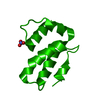[English] 日本語
 Yorodumi
Yorodumi- PDB-2x8q: Cryo-EM 3D model of the icosahedral particle composed of Rous sar... -
+ Open data
Open data
- Basic information
Basic information
| Entry | Database: PDB / ID: 2x8q | ||||||
|---|---|---|---|---|---|---|---|
| Title | Cryo-EM 3D model of the icosahedral particle composed of Rous sarcoma virus capsid protein pentamers | ||||||
 Components Components | CAPSID PROTEIN P27 | ||||||
 Keywords Keywords |  VIRUS / VIRUS /  CAPSID PROTEIN / CAPSID PROTEIN /  VIRAL MATRIX PROTEIN VIRAL MATRIX PROTEIN | ||||||
| Function / homology |  Function and homology information Function and homology informationhost cell nucleoplasm / viral procapsid maturation / host cell nucleolus /  Hydrolases; Acting on peptide bonds (peptidases); Aspartic endopeptidases / Hydrolases; Acting on peptide bonds (peptidases); Aspartic endopeptidases /  viral capsid / structural constituent of virion / viral capsid / structural constituent of virion /  nucleic acid binding / aspartic-type endopeptidase activity / host cell plasma membrane / nucleic acid binding / aspartic-type endopeptidase activity / host cell plasma membrane /  proteolysis ...host cell nucleoplasm / viral procapsid maturation / host cell nucleolus / proteolysis ...host cell nucleoplasm / viral procapsid maturation / host cell nucleolus /  Hydrolases; Acting on peptide bonds (peptidases); Aspartic endopeptidases / Hydrolases; Acting on peptide bonds (peptidases); Aspartic endopeptidases /  viral capsid / structural constituent of virion / viral capsid / structural constituent of virion /  nucleic acid binding / aspartic-type endopeptidase activity / host cell plasma membrane / nucleic acid binding / aspartic-type endopeptidase activity / host cell plasma membrane /  proteolysis / zinc ion binding / proteolysis / zinc ion binding /  membrane membraneSimilarity search - Function | ||||||
| Biological species |   ROUS SARCOMA VIRUS - PRAGUE C ROUS SARCOMA VIRUS - PRAGUE C | ||||||
| Method |  ELECTRON MICROSCOPY / ELECTRON MICROSCOPY /  single particle reconstruction / single particle reconstruction /  cryo EM / Resolution: 18.3 Å cryo EM / Resolution: 18.3 Å | ||||||
| Model type details | CA ATOMS ONLY, CHAIN A | ||||||
 Authors Authors | K Hyun, J. / Radjainia, M. / Kingston, R.L. / Mitra, A.K. | ||||||
 Citation Citation |  Journal: J Biol Chem / Year: 2010 Journal: J Biol Chem / Year: 2010Title: Proton-driven assembly of the Rous Sarcoma virus capsid protein results in the formation of icosahedral particles. Authors: Jae-Kyung Hyun / Mazdak Radjainia / Richard L Kingston / Alok K Mitra /  Abstract: In a mature and infectious retroviral particle, the capsid protein (CA) forms a shell surrounding the genomic RNA and the replicative machinery of the virus. The irregular nature of this capsid shell ...In a mature and infectious retroviral particle, the capsid protein (CA) forms a shell surrounding the genomic RNA and the replicative machinery of the virus. The irregular nature of this capsid shell precludes direct atomic resolution structural analysis. CA hexamers and pentamers are the fundamental building blocks of the capsid, however the pentameric state, in particular, remains poorly characterized. We have developed an efficient in vitro protocol for studying the assembly of Rous sarcoma virus (RSV) CA that involves mild acidification and produces structures modeling the authentic viral capsid. These structures include regular spherical particles with T = 1 icosahedral symmetry, built from CA pentamers alone. These particles were subject to cryoelectron microscopy (cryo-EM) and image processing, and a pseudo-atomic model of the icosahedron was created by docking atomic structures of the constituent CA domains into the cryo-EM-derived three-dimensional density map. The N-terminal domain (NTD) of CA forms pentameric turrets, which decorate the surface of the icosahedron, while the C-terminal domain (CTD) of CA is positioned underneath, linking the pentamers. Biophysical analysis of the icosahedral particle preparation reveals that CA monomers and icosahedra are the only detectable species and that these exist in reversible equilibrium at pH 5. These same acidic conditions are known to promote formation of a RSV CA CTD dimer, present within the icosahedral particle, which facilitates capsid assembly. The results are consistent with a model in which RSV CA assembly is a nucleation-limited process driven by very weak protein-protein interactions. | ||||||
| History |
|
- Structure visualization
Structure visualization
| Movie |
 Movie viewer Movie viewer |
|---|---|
| Structure viewer | Molecule:  Molmil Molmil Jmol/JSmol Jmol/JSmol |
- Downloads & links
Downloads & links
- Download
Download
| PDBx/mmCIF format |  2x8q.cif.gz 2x8q.cif.gz | 16.4 KB | Display |  PDBx/mmCIF format PDBx/mmCIF format |
|---|---|---|---|---|
| PDB format |  pdb2x8q.ent.gz pdb2x8q.ent.gz | 9.3 KB | Display |  PDB format PDB format |
| PDBx/mmJSON format |  2x8q.json.gz 2x8q.json.gz | Tree view |  PDBx/mmJSON format PDBx/mmJSON format | |
| Others |  Other downloads Other downloads |
-Validation report
| Arichive directory |  https://data.pdbj.org/pub/pdb/validation_reports/x8/2x8q https://data.pdbj.org/pub/pdb/validation_reports/x8/2x8q ftp://data.pdbj.org/pub/pdb/validation_reports/x8/2x8q ftp://data.pdbj.org/pub/pdb/validation_reports/x8/2x8q | HTTPS FTP |
|---|
-Related structure data
| Related structure data |  1710MC M: map data used to model this data C: citing same article ( |
|---|---|
| Similar structure data |
- Links
Links
- Assembly
Assembly
| Deposited unit | 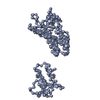
|
|---|---|
| 1 | x 60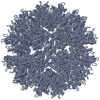
|
| 2 |
|
| 3 | x 5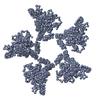
|
| 4 | x 6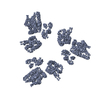
|
| 5 | 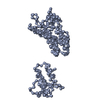
|
| Symmetry | Point symmetry: (Schoenflies symbol : I (icosahedral : I (icosahedral )) )) |
- Components
Components
| #1: Protein |  / Coordinate model: Cα atoms only / Coordinate model: Cα atoms onlyMass: 24472.230 Da / Num. of mol.: 1 / Fragment: RESIDUES 240-465 Source method: isolated from a genetically manipulated source Source: (gene. exp.)   ROUS SARCOMA VIRUS - PRAGUE C ROUS SARCOMA VIRUS - PRAGUE CDescription: RECOMBINANT ROUS SARCOMA VIRUS CAPSID PROTEIN WAS PRODUCED BY HETEROLOGOUS EXPRESSION IN E. COLI AND PURIFIED TO HOMOGENIETY Production host:   ESCHERICHIA COLI (E. coli) / Strain (production host): ROSETTA 2 / References: UniProt: P03322 ESCHERICHIA COLI (E. coli) / Strain (production host): ROSETTA 2 / References: UniProt: P03322 |
|---|
-Experimental details
-Experiment
| Experiment | Method:  ELECTRON MICROSCOPY ELECTRON MICROSCOPY |
|---|---|
| EM experiment | Aggregation state: PARTICLE / 3D reconstruction method:  single particle reconstruction single particle reconstruction |
- Sample preparation
Sample preparation
| Component | Name: ICOSAHEDRAL PARTICLES COMPOSED OF ROUS SARCOMA VIRUS CAPSID PROTEIN Type: VIRUS |
|---|---|
| Buffer solution | Name: 0.1M CITRIC ACID, 5MM MOPS/KOH, 725MM NACL, 0.25MM NA AZIDE, 0.125MM TCEP-HCL pH: 5 Details: 0.1M CITRIC ACID, 5MM MOPS/KOH, 725MM NACL, 0.25MM NA AZIDE, 0.125MM TCEP-HCL |
| Specimen | Conc.: 1.2 mg/ml / Embedding applied: NO / Shadowing applied: NO / Staining applied : NO / Vitrification applied : NO / Vitrification applied : YES : YES |
| Specimen support | Details: HOLEY CARBON |
Vitrification | Instrument: FEI VITROBOT MARK IV / Cryogen name: ETHANE Details: CRYOGEN- ETHANE, HUMIDITY- 90, TEMPERATURE- 85, INSTRUMENT- VITROBOT MARK IV, METHOD- BLOT FOR 5 SECONDS BEFORE PLUNGING, |
- Electron microscopy imaging
Electron microscopy imaging
| Microscopy | Model: FEI TECNAI 12 |
|---|---|
| Electron gun | Electron source : LAB6 / Accelerating voltage: 120 kV / Illumination mode: FLOOD BEAM : LAB6 / Accelerating voltage: 120 kV / Illumination mode: FLOOD BEAM |
| Electron lens | Mode: BRIGHT FIELD Bright-field microscopy / Nominal magnification: 42000 X / Nominal defocus max: 3000 nm / Nominal defocus min: 800 nm / Cs Bright-field microscopy / Nominal magnification: 42000 X / Nominal defocus max: 3000 nm / Nominal defocus min: 800 nm / Cs : 2 mm : 2 mm |
| Specimen holder | Temperature: 103 K |
| Image recording | Electron dose: 18 e/Å2 / Film or detector model: KODAK SO-163 FILM |
| Image scans | Num. digital images: 21 |
| Radiation wavelength | Relative weight: 1 |
- Processing
Processing
| EM software |
| ||||||||||||||||||||||||
|---|---|---|---|---|---|---|---|---|---|---|---|---|---|---|---|---|---|---|---|---|---|---|---|---|---|
CTF correction | Details: EACH MICROGRAPH | ||||||||||||||||||||||||
| Symmetry | Point symmetry : I (icosahedral : I (icosahedral ) ) | ||||||||||||||||||||||||
3D reconstruction | Method: POLAR FOURIER TRANSFORM / Resolution: 18.3 Å / Num. of particles: 1310 / Nominal pixel size: 2.5 Å / Actual pixel size: 2.5 Å Details: SUBMISSION BASED ON EXPERIMENTAL DATA FROM EMDB EMD-1710. Symmetry type: POINT | ||||||||||||||||||||||||
| Atomic model building | Protocol: RIGID BODY FIT / Space: RECIPROCAL / Target criteria: Cross-correlation coefficient / Details: METHOD--RIGID BODY REFINEMENT PROTOCOL--X-RAY | ||||||||||||||||||||||||
| Atomic model building |
| ||||||||||||||||||||||||
| Refinement | Highest resolution: 18.3 Å | ||||||||||||||||||||||||
| Refinement step | Cycle: LAST / Highest resolution: 18.3 Å
|
 Movie
Movie Controller
Controller


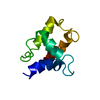
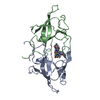
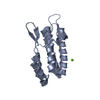
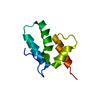
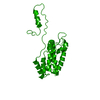
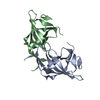
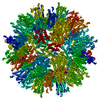

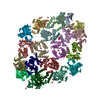

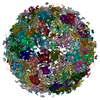
 PDBj
PDBj